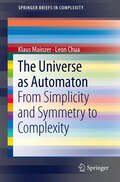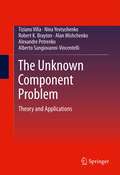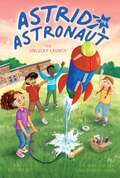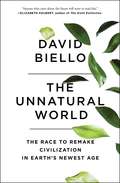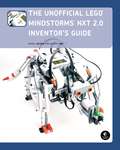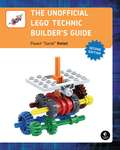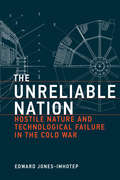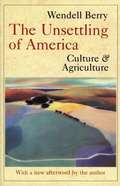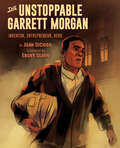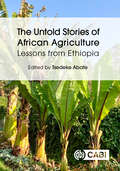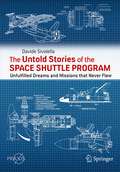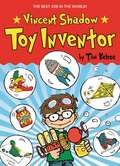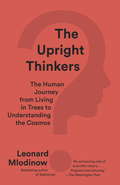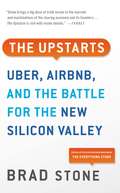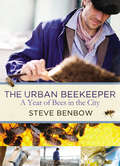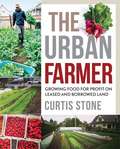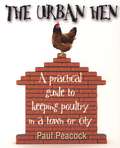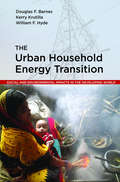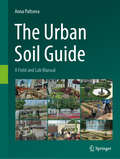- Table View
- List View
The Universe and Dr. Einstein
by Lincoln BarnettAcclaimed by Einstein himself, this is among the clearest, most readable expositions of relativity theory. It explains the problems Einstein faced, the experiments that led to his theories, and what his findings reveal about the forces that govern the universe.
The Universe as Automaton
by Klaus Mainzer Leon ChuaThis Brief is an essay at the interface of philosophy and complexity research, trying to inspire the reader with new ideas and new conceptual developments of cellular automata. Going beyond the numerical experiments of Steven Wolfram, it is argued that cellular automata must be considered complex dynamical systems in their own right, requiring appropriate analytical models in order to find precise answers and predictions in the universe of cellular automata. Indeed, eventually we have to ask whether cellular automata can be considered models of the real world and, conversely, whether there are limits to our modern approach of attributing the world, and the universe for that matter, essentially a digital reality.
The Universe: Discover What Lies Beyond Our Skies (Space Explorers)
by Abigail BeallTake a journey through the solar system and on toward distant clusters of stars with this visually stunning guide to the universe.Beginning with the Big Bang and looking forward to the future of space travel, this book is a fascinating introduction to space for budding stargazers and future astrophysicists. The Universe covers the planets of the solar system, comets, nebulae, the constellations, types of galaxies, space missions, and much more, showcasing amazing astrophotography that brings each topic to life.Beautiful illustrations by artist Dawn Cooper are combined with up-to-date images from NASA and other space agencies to inspire young readers, and info panels, timelines, and diagrams will help demystify the science behind the wonders of space.
The Unknown Component Problem
by Alberto Sangiovanni-Vincentelli Alan Mishchenko Alexandre Petrenko Tiziano Villa Robert K. Brayton Nina YevtushenkoThe Problem of the Unknown Component: Theory and Applications addresses the issue of designing a component that, combined with a known part of a system, conforms to an overall specification. The authors tackle this problem by solving abstract equations over a language. The most general solutions are studied when both synchronous and parallel composition operators are used. The abstract equations are specialized to languages associated with important classes of automata used for modeling systems. The book is a blend of theory and practice, which includes a description of a software package with applications to sequential synthesis of finite state machines. Specific topologies interconnecting the components, exact and heuristic techniques, and optimization scenarios are studied. Finally the scope is enlarged to domains like testing, supervisory control, game theory and synthesis for special omega languages. The authors present original results of the authors along with an overview of existing ones.
The Unlucky Launch (Astrid the Astronaut #2)
by Rie NealIn this second book of a brand new-chapter book series, aspiring astronaut Astrid designs a rocket!After seeing the big Space-E rocket launch, Astrid just knows she&’s going to be exploring space in a rocket of her own someday! And in honor of the big launch, Astrid and her fellow Shooting Stars will be building rockets of their very own. What&’s more exciting is the guest helper, Luke, who actually worked on the Space-E team! The Shooting Stars are working towards more points on the Astro Board and Astrid is hoping she can impress Luke enough to score a tour of Space-E headquarters. But it turns out that Luke&’s design might not be the best—and Astrid isn&’t sure if she should speak up. Can Astrid use her voice to show there is more than one solution for a perfect take-off?
The Unnatural World: The Race to Remake Civilization in Earth's Newest Age
by David BielloWith the historical perspective of The Song of the Dodo and the urgency of Al Gore's An Inconvenient Truth, a brilliant young environmental journalist argues that we must innovate and adapt to save planet Earth.Civilization is in crisis, facing disasters of our own making on the only planet known to bear life in the vast void of the universe. We have become unwitting gardeners of the Earth, not in control, but setting the conditions under which all of life flourishes--or not. Truly, it's survival of the innovators. The Unnatural World chronicles a disparate band of unlikely heroes: an effervescent mad scientist who would fertilize the seas; a pigeon obsessive bent on bringing back the extinct; a low-level government functionary in China doing his best to clean up his city, and more. These scientists, billionaires, and ordinary people are all working toward saving the best home humanity is ever likely to have. What is the threat? It is us. In a time when a species dies out every ten minutes, when summers are getting hotter, winters colder, and oceans higher, some people still deny mankind's effect on the Earth. But all of our impacts on the planet have ushered in what qualifies as a new geologic epoch, thanks to global warming, mass extinction, and such technologies as nuclear weapons or plastics. The Unnatural World examines the world we have created and analyzes the glimmers of hope emerging from the efforts of incredible individuals seeking to change our future. Instead of a world without us, this history of the future shows how to become good gardeners, helping people thrive along with an abundance of plants, animals, all the exuberant profusion of life on Earth--a better world with us. The current era of humans need not be the end of the world--it's just the end of the world as we know it.
The Unofficial LEGO MINDSTORMS NXT 2.0 Inventor's Guide
by David J. Perdue Laurens ValkThe LEGO® MINDSTORMS® NXT 2.0 set offers hundreds of building elements, programming software, and powerful electronics that you can use to create amazing robots. But where do you begin?This eagerly awaited second edition of the bestselling Unofficial LEGO MINDSTORMS NXT Inventor's Guide is your key to designing, building, and programming robots with the NXT 2.0 set.You'll learn practical building techniques, like how to build sturdy structures and use gears, and gain a solid understanding of the set's NXT-G programming language. A series of projects new to this edition offers step-by-step instructions for building and programming six robots, each of which can be built with just one NXT 2.0 set, including:–Inventor-Bot, a fast, simple, modular vehicle with treads–Sentry-Bot, a robot guard that shoots balls at intruders–Table-Bot, a vehicle that uses its antennae to avoid falling off a tabletop–The Jeep, a four-wheeled vehicle that avoids obstacles and follows lines–The Lizard, a large walking robot that uses the color sensor to detect and respond to different colored balls–The Printer, a stationary robot that uses a pen or marker to draw letters, words, and shapes on paperAdditional resources include the Piece Library, which contains basic information on the more than 80 types of LEGO pieces in the NXT 2.0 set, and the Quick Reference, which lists the 34 types of standard programming blocks.So go ahead. Grab your NXT 2.0 set, fire up your imagination, and see what you can invent with The Unofficial LEGO MINDSTORMS NXT 2.0 Inventor's Guide.
The Unofficial LEGO Technic Builder's Guide, 2nd Edition
by Pawel Sariel KmiecThis thoroughly updated second edition of the best-selling Unofficial LEGO Technic Builder’s Guide is filled with tips for building strong yet elegant machines and mechanisms with the LEGO Technic system. World-renowned builder Pawe? "Sariel" Kmiec covers the foundations of LEGO Technic building, from the concepts that underlie simple machines, like gears and linkages, to advanced mechanics, like differentials and steering systems. This edition adds 13 new building instructions and 4 completely new chapters on wheels, the RC system, planetary gearing, and 3D printing.You’ll get a hands-on introduction to fundamental mechanical concepts like torque, friction, and traction, as well as basic engineering principles like weight distribution, efficiency, and power transmission—all with the help of Technic pieces. You’ll even learn how Sariel builds his amazing tanks, trucks, and cars to scale.Learn how to:–Build sturdy connections that can withstand serious stress–Re-create specialized LEGO pieces, like casings and u-joints, and build custom, complex Schmidt and Oldham couplings–Create your own differentials, suspensions, transmissions, and steering systems–Pick the right motor for the job and transform it to suit your needs–Combine studfull and studless building styles for a stunning look–Build remote-controlled vehicles, lighting systems, motorized compressors, and pneumatic enginesThis beautifully illustrated, full-color book will inspire you with ideas for building amazing machines like tanks with suspended treads, supercars, cranes, bulldozers, and much more. What better way to learn engineering principles than to experience them hands-on with LEGO Technic?New in this edition: 13 new building instructions, 13 updated chapters, and 4 brand-new chapters!
The Unplugged Hours: Cultivating a Life of Presence in a Digitally Connected World
by Hannah BrencherNo matter what you do for a living, how much time your apps save you, or how much entertainment your phone brings, it is possible to unplug--and find an even better life on the other side.In the spring of 2021, Hannah Brencher found herself depleted and exhausted--and she knew the culprit was her constantly plugged-in lifestyle. Like so many of us, Hannah had been turning to her phone to cope with life in a time of isolation and uncertainty. Those coping mechanisms had calcified into habits she didn't know how to break. Sound familiar?That's when the nudge happened. Turn off your phone and keep turning off your phone. And a challenge was born: 1,000 unplugged hours in one year. Soon after she shared her tracker sheet on her website, thousands of people downloaded it and signed up for their own 1,000-hour challenge.Now in The Unplugged Hours, Hannah demonstrates how the act of powering down changed her entire life. It's a strikingly small thing to do and a surprisingly difficult habit to maintain, but turning off your phone has a substantial impact on your mental health, relationships, time management, and outlook on the world. A powerful weaving of memoir, cultural commentary, and spiritual insights, this life-changing book helps you:Reclaim your ability to be present and engaged with the world around youSwap the hurried, constant pace of technology for a steadier, more rooted way of livingEstablish your own unplugged rituals and rhythms in daily lifeUncover the magic within the ordinary awaiting you just beyond the screenThe Unplugged Hours gives you the practical ideas and spiritual inspiration you need to stop scrolling and start living.
The Unquiet Woods: Ecological Change and Peasant Resistance in the Himalaya
by Ramachandra GuhaThe Unquiet Woods, Ramachandra Guha's path breaking study of peasant movements against commercial forestry, offers a new epilogue that brings the story of Himalayan social protest up-to-date, reflecting the Chipko movement's continuing influence in the wider world.
The Unreliable Nation: Hostile Nature and Technological Failure in the Cold War (Inside Technology)
by Edward Jones-ImhotepAn examination of how technological failures defined nature and national identity in Cold War Canada.Throughout the modern period, nations defined themselves through the relationship between nature and machines. Many cast themselves as a triumph of technology over the forces of climate, geography, and environment. Some, however, crafted a powerful alternative identity: they defined themselves not through the triumph of machines over nature, but through technological failures and the distinctive natural orders that caused them. In The Unreliable Nation, Edward Jones-Imhotep examines one instance in this larger history: the Cold War–era project to extend reliable radio communications to the remote and strategically sensitive Canadian North. He argues that, particularly at moments when countries viewed themselves as marginal or threatened, the identity of the modern nation emerged as a scientifically articulated relationship between distinctive natural phenomena and the problematic behaviors of complex groups of machines.Drawing on previously unpublished archival documents and recently declassified materials, Jones-Imhotep shows how Canadian defense scientists elaborated a distinctive “Northern” natural order of violent ionospheric storms and auroral displays, and linked it to a “machinic order” of severe and widespread radio disruptions throughout the country. Tracking their efforts through scientific images, experimental satellites, clandestine maps, and machine architectures, he argues that these scientists naturalized Canada's technological vulnerabilities as part of a program to reimagine the postwar nation. The real and potential failures of machines came to define Canada, its hostile Northern nature, its cultural anxieties, and its geo-political vulnerabilities during the early Cold War. Jones-Imhotep's study illustrates the surprising role of technological failures in shaping contemporary understandings of both nature and nation.
The Unsettling of America: Culture and Agriculture
by Wendell BerryIn "The Unsettling of America" Wendell Berry argues that good farming is a cultural development and spiritual discipline. Today's agribusiness, however, takes farming out of its cultural context and away from families, and as a nation we are thus more estranged from the land -- from the intimate knowledge, love, and care of it. Sadly, as Berry notes in the afterword to this new edition, his arguments and observations are still relevant today. We continue to suffer loss of community, the devaluation of human work, and the destruction of nature under an economics dedicated to the mechanistic pursuit of products and profits.
The Unspeakable Unknown
by Eliot SappingfieldGuardians of the Galaxy meets The Hitchhiker's Guide to the Galaxy in this wild, warm-hearted, and hilarious sci-fi companion to A Problematic Paradox.Nikola Kross has battled aliens and won. But her father, who was kidnapped by evil extraterrestrials, is still missing, and now it's up to Nikola and her friends to find and rescue him before it's too late. He could be anywhere in the known universe, and they have little to go on except a desperate secret communication--"Kindly rescue me at your earliest convenience"--and an unhelpful clue that he's in a secure facility somewhere deep underground. But the extraterrestrials are still determined to capture Nikola. And if she gets abducted, she won't have to wonder where her father is . . . because she'll already be there. In this funny and exciting sequel, Nikola and her friends discover new and unexpected allies and come face-to-face with a strange and mysterious enemy, one so powerful and so dangerous, they dare not speak his name.
The Unstoppable Garrett Morgan: Inventor, Entrepreneur, Hero
by Joan DiCiccoGarrett Morgan, a prolific African American inventor and entrepreneur, must test his latest invention in a daring rescue after an explosion at the Cleveland Waterworks."If a man puts something to block your way,the first time you go around it,the second time you go over it,and the third time you go through it." Living by these words made inventor and entrepreneur Garrett Morgan unstoppable! Growing up in Claysville, Kentucky, the son of freed slaves, young and curious Garrett was eager for life beyond his family's farm. At age fourteen, he moved north to Cleveland, where his creative mind took flight amidst the city's booming clothing-manufacturing industry. Using his ingenuity and tenacity, Garrett overcame racial barriers and forged a career as a successful businessman and inventor. But when a tunnel collapsed, trapping twenty men, the rescue would test both Garrett's invention -- and his courage. Told in compelling prose by debut picture-book author Joan DiCicco and dynamic illustrations from artist Ebony Glenn, The Unstoppable Garrett Morgan is a powerful biography of an extraordinary man who dedicated his life to improving the lives of others.
The Untold Stories of African Agriculture: Lessons from Ethiopia
by Melaku Admasu Seid Ahmed Kemal Getinet Alemaw Dessie Ambaw Gashawbeza Ayalew Workneh Ayalew Dr Amsalu Ayana Ashenafi Ayano Ferdu Azerefegne Endashaw Bekele Getachew Belay Terefe Belehu Mintewab Bezabih Asmare Dagnew Maru Degefa Mulat Demeke Minyahel Fekadu Daneal Fekersillassie Regassa Feyissa Asnake Fikre Messele Fisseha Amare Fufa Muluken Goftishu Endeshaw Habte Konjit Hailu Karta Karke Kalsa Girma Tesfahun Kassie Friew Kelemu Tolera Keno Rahwa Kidane Berga Lemaga Abebe Menkir Takele Negewo Hawani Negussie Mesfin Shenkut Amare Tegbaru Kindie Tesfaye Taye Tessema Melaku Wale Wondimagegnehu Mersie Zerihun Yemataw Firehun Yirefu Mikael Fisseha Yohannes Engida Zemedagegnehu Olubunmi A. BosseyThis landmark volume presents the results of a comprehensive and coherent in-depth assessment of Ethiopian agriculture and draws lessons from it to generate actionable recommendations that will inform policy decisions and priority setting for agricultural transformation across Africa. Policy makers in Africa are faced with the challenges of ensuring food and nutrition security and the economic wellbeing of their rapidly growing populations while at the same time maintaining the integrity of their natural resource base. Between 2000 and 2021, 74% of the growth in overall crop production on the continent was derived from increases in land area expansion, while increases in yield contributed only 26% of the growth. This unchecked expansion of land use puts the sustainability of the natural resource base under severe pressure. Even though some countries have made substantial increases in their farm productivity over the last two decades, the overall performance for Africa is far behind other regions. For the most part, in Africa, agriculture is not fulfilling its expected functions of food and nutrition security, increased export earnings, import substitution, and raw material supply for local industries. Attempts have been made to transform African agriculture over the years, but few countries have succeeded in achieving sustainable change. Using examples from Ethiopia this book identifies the major factors for success and the root causes of underperformance, and offers evidence-based recommendations for future decision making, policy change and the creation of growth. This book: · Draws on a unique set of case studies from Ethiopia described and told from a truly African perspective. · Emphasises to policy makers in Africa that development cannot be outsourced and there are no shortcuts; it is only through consistent effort and sustained support for their agricultural research and development that positive change can be brought about. · States that past agricultural development efforts by the international community have not properly included a strong African voice, and that therefore, all future academic research, policies and strategies dealing with the continent's agriculture and food security should be formulated by Africa's own leading thinkers and experts. · Is not a polemic; its arguments are knowledge and evidence based, building a compelling picture of how agricultural development can be sustained for the future.
The Untold Stories of the Space Shuttle Program: Unfulfilled Dreams and Missions that Never Flew (Springer Praxis Books)
by Davide SivolellaIn September 1969, several months after the Apollo 11 lunar landing, President Richard M. Nixon established the Space Task Force to chart NASA’s path for the decades to come. This imaginative vision was shattered less than six months later when, on January 13, 1970, NASA Administrator Dr. Thomas Paine announced that, owing to funding cuts, only the reusable Space Shuttle could be afforded -- there would be no space station, no return to the Moon, and no missions to Mars. This is a story never before told about the missions and technologies that NASA had begun to plan but never fully realized. The book is a companion to the author’s previous two works on the Space Shuttle. Whereas the first two books showed how the Space Shuttle flew in space and what the program accomplished, this book explains what more the Space Shuttle could have achieved and how the space transportation system could have further matured if circumstances had been otherwise. A final chapter also discusses how some of these plans might be resurrected in future programs.
The Unusual Mind of Vincent Shadow (Vincent Shadow #1)
by Tim KehoeVincent Shadow isn't particularly good at sports and is constantly being picked on by his classmates at Central Middle School. But it is Vincent's unusually creative mind that truly separates him from other kids his age. Vincent's top secret attic lab is crammed with toy prototypes --from Liquid Superballs to Bullz-I Basketballs and Sonic Snorkelz--and he has a sketch book filled with drawings of toys he still wants to build. So when a chance encounter with an eccentric toy inventor offers him the opportunity to go from unknown weird kid to toy inventor extraordinaire, Vincent realizes that playtime is over: it's time to get serious about toys.
The Upright Thinkers: The Human Journey from Living in Trees to Understanding the Cosmos
by Leonard MlodinowA few million years ago, our ancestors came down from the trees and began to stand upright, freeing our hands to create tools and our minds to grapple with the world around us. Leonard Mlodinow takes us on a passionate and inspiring tour through the exciting history of human progress and the key events in the development of science. In the process, he presents a fascinating new look at the unique characteristics of our species and our society that helped propel us from stone tools to written language and through the birth of chemistry, biology, and modern physics to today's technological world. Along the way he explores the cultural conditions that influenced scientific thought through the ages and the colorful personalities of some of the great philosophers, scientists, and thinkers: Galileo, who preferred painting and poetry to medicine and dropped out of university; Isaac Newton, who stuck needlelike bodkins into his eyes to better understand changes in light and color; and Antoine Lavoisier, who drank nothing but milk for two weeks to examine its effects on his body. Charles Darwin, Albert Einstein, Werner Heisenberg, and many lesser-known but equally brilliant minds also populate these pages, each of their stories showing how much of human achievement can be attributed to the stubborn pursuit of simple questions (why? how?), bravely asked. The Upright Thinkers is a book for science lovers and for anyone interested in creative thinking and in our ongoing quest to understand our world. At once deeply informed, accessible, and infused with the author's trademark wit, this insightful work is a stunning tribute to humanity's intellectual curiosity. (With black-and-white illustrations throughout.)From the Hardcover edition.
The Upstarts: How Uber, Airbnb, and the Killer Companies of the New Silicon Valley Are Changing the World
by Brad StoneA look deep inside the new Silicon Valley, from the New York Times bestselling author of The Everything Store Ten years ago, the idea of getting into a stranger's car, or a walking into a stranger's home, would have seemed bizarre and dangerous, but today it's as common as ordering a book online. Uber and Airbnb have ushered in a new era: redefining neighborhoods, challenging the way governments regulate business, and changing the way we travel.In the spirit of iconic Silicon Valley renegades like Steve Jobs and Bill Gates, another generation of entrepreneurs is using technology to upend convention and disrupt entire industries. These are the upstarts, idiosyncratic founders with limitless drive and an abundance of self-confidence. Led by such visionaries as Travis Kalanick of Uber and Brian Chesky of Airbnb, they are rewriting the rules of business and often sidestepping serious ethical and legal obstacles in the process.The Upstarts is the definitive story of two new titans of business and a dawning age of tenacity, conflict and wealth. In Brad Stone's riveting account of the most radical companies of the new Silicon Valley, we discover how it all happened and what it took to change the world.
The Urban Beekeeper: A Year of Bees in the City
by Steve BenbowAt a time when the UK bee population is in decline there's no better way to make a difference than to start up your own beehive. Steve Benbow's enormous success with urban beekeeping show's how easy it is to keep bees, whether you're in the city or in the countryside, a beginner or an experienced beekeeper, and you'll never look back once you've tasted your very own sticky, golden honey, or lit a candle made from the beeswax from your beehive.Steve Benbow is a visionary beekeeper who started his first beehive ten years ago on the roof of his tower block in Bermondsey and today runs 30 sites across the city. His bees live atop the Tate Modern and Tate Britain, Fortnum & Mason and the National Portrait Gallery, and he supplies honey to the Savoy tearooms, Harvey Nichols, Harrods and delis across London. His bees forage in parks, cemeteries, along railway lines and in window boxes, and because of the diversity of the plants and trees in the city, produce far richer honey and greater yields than they would in rural areas.The Urban Beekeeper is a fact-filled diary and practical guide to beekeeping that follows a year in the life of Steve and his bees and shows how keeping bees and making your own delicious honey is something anyone can do. It is a tempting glimpse into a sunlit lifestyle that starts with the first rays of the morning and ends with the warm glow of sunset, filled with oozing honeycomb, recipes for sensational honey-based dishes, and honey that tastes like sunshine. A hugely affectionate but practical diary of a beekeeper's year and the immense satisfaction of harvesting your own delicious honey. Read it and join the revolution.
The Urban Farmer
by Curtis Allen StoneThere are twenty million acres of lawns in North America. In their current form, these unproductive expanses of grass represent a significant financial and environmental cost. However, viewed through a different lens, they can also be seen as a tremendous source of opportunity. Access to land is a major barrier for many people who want to enter the agricultural sector, and urban and suburban yards have huge potential for would-be farmers wanting to become part of this growing movement.The Urban Farmer is a comprehensive, hands-on, practical manual to help you learn the techniques and business strategies you need to make a good living growing high-yield, high-value crops right in your own backyard (or someone else's). Major benefits include: Low capital investment and overhead costs Reduced need for expensive infrastructure Easy access to marketsGrowing food in the city means that fresh crops may travel only a few blocks from field to table, making this innovative approach the next logical step in the local food movement. Based on a scalable, easily reproduced business model, The Urban Farmer is your complete guide to minimizing risk and maximizing profit by using intensive production in small leased or borrowed spaces.Curtis Stone is the owner/operator of Green City Acres, a commercial urban farm growing vegetables for farmers markets, restaurants, and retail outlets. During his slower months, Curtis works as a public speaker, teacher, and consultant, sharing his story to inspire a new generation of farmers.
The Urban Hen: A Practical Guide To Keeping Poultry In A Town Or City
by Paul Peacock"The Urban Hen" is the perfect companion for the city poultry keeper and shows you how to maintain a happy, healthy garden or backyard flock in towns and cities. Paul Peacock shows you how to: find the best poultry for the small garden and house them properly, feed your birds, tune in to their daily needs and enjoy your own eggs; avoid annoying the neighbours by showing that it is possible to keep poultry without attracting unwelcome pests; recognise healthy happy birds and learn their daily routine; recognise poorly hens; treat them or get help; and, incubate and care for fertilised eggs and raise chicks.
The Urban Hen: A practical guide to keeping poultry in a town or city
by Paul Peacock"The Urban Hen" is the perfect companion for the city poultry keeper and shows you how to maintain a happy, healthy garden or backyard flock in towns and cities. Paul Peacock shows you how to: find the best poultry for the small garden and house them properly, feed your birds, tune in to their daily needs and enjoy your own eggs; avoid annoying the neighbours by showing that it is possible to keep poultry without attracting unwelcome pests; recognise healthy happy birds and learn their daily routine; recognise poorly hens; treat them or get help; and, incubate and care for fertilised eggs and raise chicks.
The Urban Household Energy Transition: Social and Environmental Impacts in the Developing World
by Douglas F. Barnes William F. Hyde Kerry KrutillaAs cities in developing countries grow and become more prosperous, energy use shifts from fuelwood to fuels like charcoal, kerosene, and coal, and, ultimately, to fuels such as liquid petroleum gas, and electricity. Energy use is not usually considered as a social issue. Yet, as this book demonstrates, the movement away from traditional fuels has a strong socio-economic dimension, as poor people are the last to attain the benefits of using modern energy. The result is that health risks from the continued use of wood fuel fall most heavily on the poor, and indoor pollution from wood stoves has its greatest effect on women and children who cook and spend much more of their time indoors. Barnes, Krutilla, and Hyde provide the first worldwide assessment of the energy transition as it occurs in urban households, drawing upon data collected by the World Bank Energy Sector Management Assistance Programme (ESMAP). From 1984-2000, the program conducted over 25,000 household energy surveys in 45 cities spanning 12 countries and 3 continents. Additionally, GIS mapping software was used to compile a biomass database of vegetation patterns surrounding 34 cities. Using this rich set of geographic, biological, and socioeconomic data, the authors describe problems and policy options associated with each stage in the energy transition. The authors show how the poorest are most vulnerable to changes in energy markets and demonstrate how the collection of biomass fuel contributes to deforestation. Their book serves as an important contribution to development studies, and as a guide for policymakers hoping to encourage sustainable energy markets and an improved quality of life for growing urban populations.
The Urban Soil Guide: A Field and Lab Manual
by Anna PaltsevaDelve into the fascinating world of soil science with "The Urban Soil Guide," a comprehensive manual designed for everyone from science beginners to seasoned horticulturists. Whether you're an introductory science student, a passionate gardener, a landscape designer, or a professional horticulturist, this guide is tailored for you. Packed with a variety of hands-on activities, this guide makes learning soil science both accessible and enjoyable. From simple experiments that can be performed in your kitchen to more advanced techniques, it offers a practical approach to understanding soil. Written by a soil scientist, this guide bridges the gap between professional knowledge and amateur enthusiasm. The Urban Soil Guide is versatile enough to serve as a textbook in botanical gardens and university classes, while also being an invaluable resource for amateurs. Choose activities that match your interest and level of expertise. Embark on your journey to becoming a soil expert with The Urban Soil Guide – your hands-on companion in the world of soil science.

